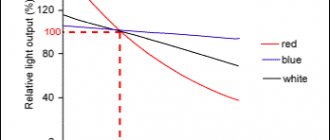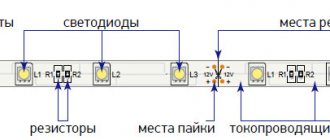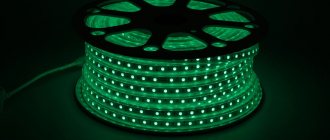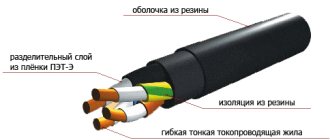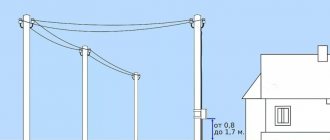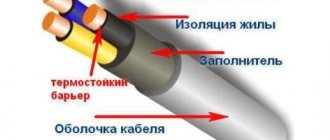NYM copper cable is a popular conductor used in the construction of internal wiring of residential and administrative buildings. It can be installed inside many other buildings, including mid-level fire-hazardous structures.
The product originally appeared in Europe, hence the Latin letters in the abbreviation. Today, the product is manufactured in many European countries and in several Russian factories. Cable products from Sevkabel and Pskovkabel are in no way inferior in quality to imported NYM products.
Application area
NYM cable can be used in various climatic zones, inside production facilities with low or high humidity levels, in domestic and living rooms and even outdoors. When installing outdoors, it is important to avoid direct exposure to ultraviolet rays of the sun.
Inside residential buildings, wire is used in different cases: both with open and hidden wiring. It is used to switch lighting equipment, electrical sockets, switches and other devices. When installing a line in open ground, the cable must be protected using corrugated pipes or special boxes. When laid aerially, NYM is reinforced with high-quality overpasses. For any electrical devices that require a seal at the input, it is best to use just such a cable.
NYM – confidence for many years
This is a German analogue of the VVG cable. Only it is manufactured in accordance with the German standard DIN VDE Normenleitung. It is characterized by high reliability, safety and long service life - up to 40 years. It is most often chosen for installation in apartments, cottages, office buildings, commercial and industrial premises. Many manufacturers offer frost-resistant cables, the operating temperature of which can reach -50 °C. Therefore they are suitable for installation in unheated rooms.
Also, the NYM sheath is not afraid of ultraviolet radiation, unlike VVG - you can install the cable where direct sunlight hits. It is also easy to cut without special tools, which electricians appreciate.
Understanding the labeling
- N (normenleitung) – manufactured according to VDE standard
- Y (ysolationsschicht) – polyvinyl chloride insulation
- M (mantelleitung) – there is an outer shell
This type of cable can have from 1 to 7 copper cores. The cross section can reach 6 square meters. mm. You can find a product marked ls (low smoke), which means reduced smoke production when heated. The letter J indicates the presence of a yellow-green protective ground conductor. If there is no letter after the name or there is the letter O, this means there is no grounding conductor.
Explanation of the abbreviation NYM
The Latin abbreviation NYM stands for the following:
- N – standard type cable (German gradation);
- Y – the insulating sheath of the cores is made of polyvinyl chloride (PVC);
- M – with outer shell.
As usual, the absence of the letter “A” in the first place indicates that the cable cores are made of copper. In addition to the three standard letters in the designation, J or O can be added through a hyphen - with or without a yellow-green conductor (ground conductor).
After the alphabetic symbols there are necessarily digital symbols, indicating the number of cores and the cross-section of each of them. For example, the product NYM-O 4×4.5 - 0.66 can be deciphered as follows:
- standard cable with polyvinyl chloride core insulation and outer sheath;
- consists of four cores with a cross-sectional area of 4.5 square meters. mm each;
- used at voltages up to 0.66 kV (660 V).
Color coding
Such a cable must be produced with standardized color markings. The absence of this indicates that the product is not certified and is a counterfeit. The standards for the color of conductors are prescribed in the rules for electrical installations (PUE).
The set of colors varies depending on the exact number of cores located inside the outer sheath:
- there are no regulations for single-core cables;
- two conductors without a grounding cable - black and blue conductors;
- three cores without a grounding cable - black, brown and gray;
- four cores without a grounding cable - black, brown, gray and blue;
- three cores with a grounding cable - black, blue and yellow-green;
- four cores with a grounding cable - black, brown, gray and yellow-green;
- five cores with a grounding cable - black, brown, grey, blue and yellow-green.
Depending on the color marking, specialists can easily determine the main purpose of the cable. The blue wire is usually used to connect the neutral wire in single-phase networks. In three-phase, the blue core acts as a neutral. The yellow-green conductor in all cases serves as a grounding conductor.
Important! In accordance with GOST, the NYM cable should not contain conductors with white or white-blue insulation. If there is one, the conclusion is simple - it is a fake. Further use of such products, if possible, is at your own peril and risk.
Types of NYM power cable
There are several modifications of this wire brand that have similar technical characteristics, but slight differences in design. NYM-J must have a yellow-green ground wire or a blue zero wire, while NYM-O is equipped with a black wire. Options for color marking of insulation of these varieties are presented in Table 1.
Table 1
| Number of cores | Color | NYM-J | Number of cores | Color | NYM-O |
| 3 | yellow-green, blue, black, | Single phase + ground | 2 | black blue, | One phase without ground |
| 4 | brown, black, gray, yellow-green, | Three phases + ground, without zero | 3 | brown, gray, black, | Three phases without ground and zero |
| 5 | black, grey, yellow-green, brown, blue, | Three phases + ground + zero | 4 | blue, brown, black, gray, | Three phases + zero without ground |
The most popular cross-section options preferred by NYM power wire buyers include: 1.5 and 2.5 mm² for a 2-core cable, 2.5 and 4 mm² for a 3-core cable.
Design features
Domestic manufacturers produce several modifications of the NYM cable. Some of them are designed in full compliance with German standards and requirements (VDE), others are designed according to customer specifications. In most cases, each plant uses its own developments, prescribed in the technical specifications, and the cable can be called differently - from NUM or NUM to NUM. This suggests that there is no strict general standard here. As a result, you can buy what appears to be NYM on the market, but in fact purchase domestic analogues, the technical and operational characteristics of which differ significantly from German standards.
An example of inconsistencies include leaks of the compound used when filling the free space between the cores. German engineers require the use of a compound made of chalk-filled rubber, but the specifications of domestic manufacturers may indicate a different material characterized by less strength and a weak thermal coefficient. This leads to the appearance of various leaks.
The NYM wire can use a monolithic core structure, the cross-sectional area of which should not exceed 10 square meters. mm or stranded. Many people mistakenly call a multi-core cable, but in reality we are talking about the structure of one specific core. The cross-section of stranded conductors is in the range of 16-35 square meters. mm.
Thus, the NYM cable consists of several copper cores insulated with polyvinyl chloride plastic. All conductors are covered with a non-flammable layer, on top of which an external insulation made of polyvinyl chloride is placed. In accordance with GOST, each wire has a specific color marking.
How is it deciphered?
The abbreviation NYM stands for:
- N – Normenleitung standard (German cable classification standard);
- Y – insulation is represented by polyvinyl chloride (PVC);
- M – installation in various conditions is allowed;
In addition, it should be noted that the NYM cable marking can have varieties with the prefix “-J” or “-O”, which respectively means the presence of a yellow-green or blue wire (ground or zero).
The cable may also contain the abbreviation VDE (Veiband Deutscher Electrotechniker), which means that the product meets all standards and can be used in fire hazardous areas.
Specifications
Let us briefly list all the technical and operational parameters of NYM:
- number of cores - from two to five;
- maximum permissible voltage - 660 V at an alternating current frequency of 50 Hz;
- flexible cable;
- no need to heat up during installation;
- The gasket is permissible at a minimum temperature of -5 degrees. Celsius;
- operating temperature range from -50 to +50 degrees. Celsius;
- service life – 40 years;
- permissible bending radius - four outer diameters;
- Resistant to open fire, does not spread fire.
Classification and price
Cables are available with different numbers of cores. Their number is from 1 to 5. Some enterprises produce products with the number of cores up to 7. The wire also differs in the cross-sectional area of the conductors, ranging from 1.5 to 6 square meters. mm.
The level of prices depends on the characteristics of the cable and the pricing policy of the selling company. The cost ranges from 20 to 500 rubles per linear meter, taking into account the characteristics of the wire and the above conditions. By purchasing products in bulk, the client can receive a discount.
Advantages and disadvantages
Among many conductors, NYM cable is considered to be the “golden mean”. To better understand its quality, let’s consider the main advantages of this product:
- Increased elasticity, ease of installation and operation. This flexibility is due to the presence of an internal insulating layer of rubber. This advantage is very important when performing any installation work on electrical wiring, as well as when installing equipment in inaccessible or hard-to-reach places. The wire is not affected by dampness and moisture, so it can be laid along the ground over long distances.
- If we talk about NYM, manufactured according to German quality standards, then before entering the market it must undergo numerous studies and tests. The Germans have long earned the title of the most reliable and high-quality manufacturers of industrial and other products, so there is no doubt about the integrity of the insulation and the compliance of the cable with all the declared technical and operational properties.
- The product does not support combustion, which was made possible due to the choice of material for the inner layer.
- Most specialists and electricians recommend using the product to connect lighting systems and power circuits.
- Long service life spanning several decades.
The most obvious disadvantage of NYM cable is its high cost. There are many domestic analogues, albeit with worse characteristics, the prices of which are several times lower.
Advantages of NUM cable
- High elasticity. In principle, this is one of the reasons for the high popularity of the conductor. It is easy to install in hard-to-reach places.
- Sufficiently high fire safety of operation. The NUM wire does not support combustion, but laying it in a bundle is still not recommended.
- The characteristics described above allow the use of this type of electrical wiring in wooden buildings.
- The color design of the cores meets the standards.
What is the difference between NYM and VVGng
The NYM cable will be useful only for single installations. If you are planning a group session, then it is better to make a choice in favor of VVG. Structurally, both products consist of several copper cores with polyvinyl chloride insulation and the same outer shell. However, only VVGng (the prefix “ng” indicates the non-flammability of the cable) is able to stop the flame and prevent its spread during group installation of several conductors.
We list the main technical and operational characteristics of NYM and VVGng and compare them in the table below:
| Characteristic | NYM | VVGng |
| Allowable voltage | 660 V | 660 V |
| Current frequency | 50 Hz | 50 Hz |
| Number of cores | 2-5 pcs. | 1-5 pcs. |
| Cross-sectional area of one core | 1.5-35 sq. mm | 1.5-240 sq. mm |
| Lifetime | 40 years | 30 years |
| Filling empty space | Present | Absent |
| Does not support fire spread | Single gasket only | Any gasket, including group gasket |
| Possibility of operation in difficult conditions | Moisture protection, not UV resistant | Can be used in any situation |
Design and advantages of using NYM cable
NYM power cable design elements include:
- copper mono- or multi-wire stranded conductors (2-5 pcs.),
- non-flammable PVC insulation of standard colors (see article “Marking of wires for home electrical networks. Color of wires”),
- the intermediate extruded layer-sheath, which is located on top of the cores and fills the gaps between them, is made of unvulcanized, so-called chalk-filled rubber with a high oxygen index and gives the wire a round shape,
- The outer protective shell is made of self-extinguishing PVC plastic.
Among the main advantages of the NYM power cable are:
· high elasticity, which simplifies installation of the product, especially when laying over long distances or in hard-to-reach places,
· special design of the intermediate shell. It performs the function of sealing the conductor and facilitates the cutting procedure,
· non-flammable material of the insulator and shell ensures localization of fire, incl. for single installation,
· high quality, which is manifested in strict compliance of the core section and thickness of the insulator with the passport data,
· a huge number of positive reviews from professional electrical installers. They strongly recommend using this brand in cases permitted by design documentation.
Manufacturers NYM
NYM cable is produced at foreign and domestic enterprises. The most popular factories in our country are:
- "Sevkabel";
- "Technoton";
- "Concord";
- "Pskovkabel";
- "Kamkabel".
Any products of these enterprises undergo all necessary stages of certification in accordance with international quality standards. For foreign companies, we will highlight the German TKD Kabel, Lapp Kabel and Helukabel, the French Nexans and the Turkish Denizli Cable.
NYM is stored and transported in special coils or drums, the diameter of which can be eight times the thickness of the cable itself. During storage, it is better to use a hard-to-reach and closed place, the minimum temperature of which is not lower than -15 degrees. Celsius. Also be sure to avoid direct exposure to direct sunlight.
VVG – a safe solution for residential premises
If you ask electricians what is the most common type of cable for residential buildings, they will answer - VVG. This is the most popular solution for internal electrical networks and closed electrical installations with voltages up to 1 kV. The maximum service life is 30 years. This type of cable replaced PVS as more reliable. But at the same time, this is one of the most budget options on the market, which is why it is in such great demand.
Understanding the labeling
- B – PVC core insulation
- B – PVC outer sheath
- D – there is no external armor or other additional protective layers
It uses copper cores, which can be from 2 to 5 pieces. The manufacturer also indicates the cross section. For example, 3x2.5 indicates the presence of three cores and a cross-section of 2.5 square meters. mm.
There are several varieties in this category of electrical products:
- VVGng - does not propagate combustion due to special additives in the insulating layer; several cables can be laid in one channel without additional protection of each with corrugation;
- VVGng-ls is a non-flammable cable that produces a low amount of smoke when melted, therefore ideal for residential premises;
- VVGng-frls is perhaps the safest cable in this category, as it does not support combustion, has a low level of smoke generation, is resistant to high temperatures and even open fire, all thanks to additional mica insulation.
Cable laying features
Despite the fact that the technical documentation states that the NYM wire is non-flammable, it would be a mistake to believe that it is absolutely not susceptible to fire. The main condition for non-flammability is the absence of bundles and other cables laid nearby.
Another feature of this brand of cable is its sensitivity to ultraviolet radiation, so it cannot be used in open spaces. On the other hand, the above VVGng has identical parameters and a much wider scope of application. It is suitable for both indoor and outdoor installations. VVGng can be safely used to enter an electric line from a pole to a house or when arranging a branch directly behind the SIP wire.
That is why many experts consider VVGng an improved analogue of the NYM cable. The foreign analogue is considered to be the MMJ wire, which is devoid of the above disadvantage. This is what is used for external installation.
FAQ
Question No. 1. What happens to the cable during a short circuit? Is it really that non-flammable?
When a short circuit occurs, the protection system must first operate, de-energizing the room. Insulation that consists of non-flammable material will protect your wiring as much as possible, but it is still not recommended to play with such things.
Question No. 2. Is it possible to lay the cable directly underground? What consequences should we expect?
One of the features of the cable is that the conductor can also be used for laying in the ground, but in order to avoid various troubles, it is still recommended to additionally thread the cable into the corrugation. Then no consequences will be terrible.
Question No. 3. Is it possible to plaster the cable?
Yes, the cable design allows this, so you can plaster without any problems.
Question No. 4. Is it possible to lay a cable in a screed and under a suspended ceiling without using corrugation?
The basic requirements of the rules for such work show the very possibility of installing external installation exclusively in boxes or pipes, and hidden directly inside wooden or similar walls - in protection using metal of any product (wire, cord), including NYM.
Tips for choosing
When going to the market for such a cable, be careful, since most of the products that sellers call the domestic analogue of NYM wire are fake. This is evidenced by the lack of necessary markings. When choosing a cable, pay attention to the logo and markings shown. Reliable and trusted manufacturers always put their own markings on the product. This already provides some kind of guarantee that the manufacturer is not afraid to bear responsibility for the products produced and is confident in their quality.
Sales consultants or ordinary market traders may recommend that you purchase SHVVP or PVS wires, stating that they are an excellent analogue of the NYM cable. You should not fall for such tricks, since in the case of SHVVP and PVS we are talking about ordinary cords. The main characteristic that distinguishes a cord from a cable product is related to its operational capabilities. The first is often suitable exclusively for switching household appliances and equipment, and the second is for connecting all wiring and more complex equipment.
Be sure to choose a cable with a grounding, yellow-green conductor, which will allow you to ensure high safety when operating equipment and home wiring. When choosing a product cross-section, you need to be guided by simple and general rules. When connecting lighting systems, it is enough to use wires with a cross-section of 1.5 square meters. mm, socket or switches - 2.5, oven or electric oven - from 4.5 sq. mm.
Despite the numerous domestic factories that are trying to produce high-quality NYM cable, in this case it is best to give preference to foreign factories from Germany, France or Turkey. Who knows, perhaps in a few years the situation will change, but for now we are forced to state this sad fact. In terms of operation, NYM is only suitable for internal single gasket applications. The product does not support any other options: you should not be fooled by the persuasion and deception of sellers!
KG – designed for harsh conditions
Perhaps the best solution for outdoor use is a cable marked KG. It has an insulating layer of rubber based on natural rubber. Moreover, such insulation is used both outside and for the cores themselves. This helps the product maintain high flexibility even in severe frost, and also makes it resistant to ultraviolet radiation - the shell does not crack. Withstands high air humidity. It is suitable for outdoor lighting of cottages, private houses, and enterprises. Can be used in car washes and production areas. It is often the basis for creating extension cords and powering equipment.
Understanding the labeling
- K – cable
- G – flexible
It has copper cores - from 1 to 5 pieces. The cross section can be up to 95 square meters. mm. For example, the 3x4 marking means that the cable is three-core and the cross-section of the cores is 4 square meters. mm. There are also additional letter designations: t – the cable is suitable for tropical zones and rooms with air humidity up to 98%; n – non-flammable with oil-resistant insulation; chl – resistant to cold, withstands frosts down to -60 °C.
What to consider when choosing a cable
Within each described category there are subtypes, and you have probably already decided on the most suitable cable for your requirements. But there are also general tips that guide your purchase.
- First, consider the voltage. In a household network its value is 220 - 230 V, in an industrial network - 380 V and higher. Here you will find a cable for both needs. The main thing is to pay attention to the number of cores.
- Secondly, calculate the cross section. It depends on the type of gasket - open or closed, current strength and connected power. If you do not know these parameters, it is better to contact an electrician. And according to his calculations, order the required cable.
- Thirdly, pay attention to which document the cable is made from. In Russia this may be TU or GOST. If the installation will take place at an enterprise where the parameters of the electrical network are strictly controlled, it makes sense to give preference to GOST.
- Fourthly, calculate the length and decide how it will be more convenient to buy the required quantity. Manufacturers offer cable in a coil, coiled, on a reel and cut to individual lengths.
- Fifth, consider the country of production. You can purchase products from China, Russia, Europe and the USA. Products differ in price, workmanship and warranty.
If you need advice on selection, please contact our managers. They will help you choose the right cable and guide you through the parameters.
